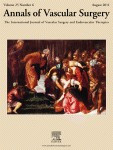Veselka J, Zimolová P, Špaček M, Hájek P, Malý M, Tomašov P, Martinkovičová L, Zemánek D. Ann Vasc Surg. 2011 Aug;25(6):796–804. Epub 2011 May 6. IF: 1,332

Abstract:
BACKGROUND: Carotid artery stenting (CAS) is the method of choice for carotid artery revascularization of patients at high risk for carotid endarterectomy. In this study, we compared the midterm results of CAS in patients with unilateral versus bilateral carotid artery disease. METHODS AND RESULTS: This is a retrospective analysis of 1-year outcome of 273 consecutive patients in whom 342 CAS procedures were performed. The incidence of periprocedural transient ischemic attacks (TIAs) differed significantly (8% vs. 1%; p = 0.01) among patients with and without bilateral internal carotid disease, and a tendency to a lower occurrence of early adverse events (death, stroke, periprocedural TIA, periprocedural myocardial infarction) was subsequently shown (11% vs. 5%; p = 0.12). At 1-year follow-up, there was a high incidence of adverse events (death, stroke, periprocedural TIA, periprocedural myocardial infarction, restenosis) in patients with bilateral carotid artery disease (40% vs. 14%; p < 0.01), which was mainly driven by a higher incidence of death, periprocedural TIA, and restenosis (p ≤ 0.02 for all). According to multivariate analysis, the independent predictors of midterm adverse events were left ventricular dysfunction, male gender, bilateral carotid artery disease, renal insufficiency, cerebral symptoms within the last 6 months before the intervention, and low-density lipoprotein cholesterol level. CONCLUSIONS: At midterm follow-up, patients with bilateral carotid artery disease treated by CAS have significantly more adverse events than those with unilateral disease.
